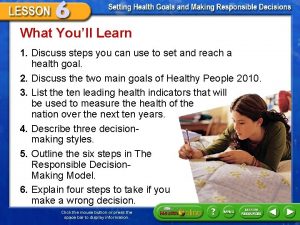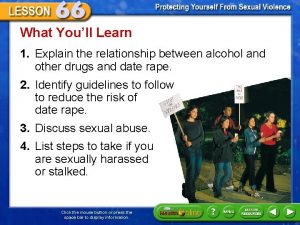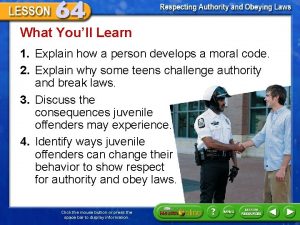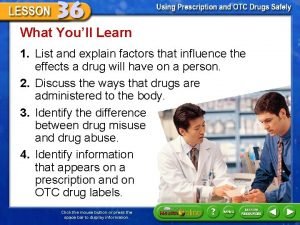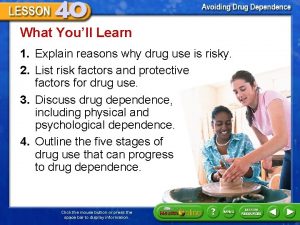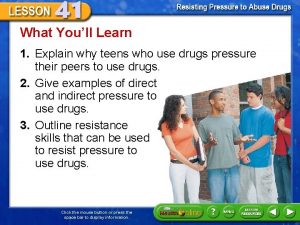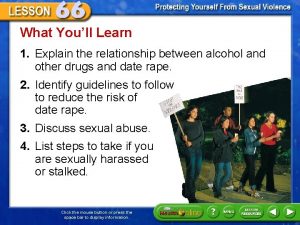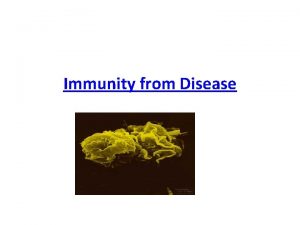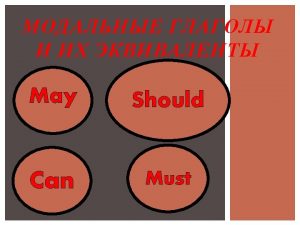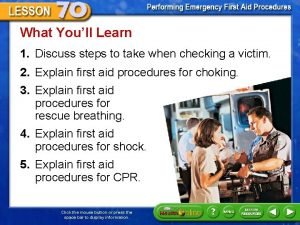What Youll Learn 1 Explain how you can



































- Slides: 35

What You’ll Learn 1. Explain how you can prevent body odor and treat acne. 2. Discuss common foot problems, including athlete’s foot, ingrown toenails, blisters, calluses, corns, and bunions. 3. Discuss the causes and treatments of warts, moles, and psoriasis. Click the mouse button or press the space bar to display information.

What You’ll Learn 4. Discuss the possible risks of tattoos, body piercings, artificial fingernails, and tanning beds. 5. Discuss how to keep hair clean, what to do about dandruff, products for hair care, and hair removal. Click the mouse button or press the space bar to display information.

Key Terms • • • dermatologist acne antiperspirant deodorant moles psoriasis athlete’s foot warts dandruff lice

Caring for Skin and Nails • Clean your skin thoroughly before going to bed. • Eat a well-balanced diet. • Drink plenty of water to help flush toxins out of your body. Click the mouse button or press the space bar to display information.

How to Care for Skin and Nails • What to do if you have smelly feet – Foot odor is caused by bacteria. – Wash your feet regularly with soap and wear clean socks every day. – Let your shoes air out after you wear them. Click the mouse button or press the space bar to display information.

How to Care for Skin and Nails • Why some grooming products make your skin red and itchy – Some people have sensitive skin and may have a reaction to a grooming product. – If a rash develops, stop using the product and contact a dermatologist or other physician. – A dermatologist is a physician who specializes in skin care. Click the mouse button or press the space bar to display information.

How to Care for Skin and Nails • What is acne? – Acne is a skin disorder in which pores are plugged with sebum, or oil, dead skin cells, and bacteria. – Comedones are one type of acne lesions. – Factors that cause acne include hormones, excess sebum, bacteria, and inflammation. – Acne is not caused by foods, beverages, or dirt. Click the mouse button or press the space bar to display information.

How to Care for Skin and Nails • How to treat acne – Wash your skin gently with a cleanser or an over-the-counter topical medication, keep hair away from your face, select water-based cosmetics, and limit time in the sun. – Do not squeeze, pick, scrub, or pop acne, which can cause infection and scars. – Contact a dermatologist if you have severe acne, because untreated acne may result in permanent scarring. Click the mouse button or press the space bar to display information.

How to Care for Skin and Nails • How to prevent body odor – Body odor occurs when perspiration combines with bacteria – Body odor can be prevented by regular bathing and use of an antiperspirant or a deodorant. • An antiperspirant reduces the amount of perspiration. • A deodorant reduces the amount of bacteria, may reduce the amount of perspiration, and contains fragrance to cover up odor. Click the mouse button or press the space bar to display information.

How to Care for Skin and Nails • What are moles? – Moles are smooth, raised areas on the skin that can be lighter or darker than surrounding skin. – Sun exposure increases the number of moles and may cause some moles to darken. Click the mouse button or press the space bar to display information.

How to Care for Skin and Nails • What are moles? – Some moles can develop into malignant melanoma, a serious form of cancer. – Most moles are not a threat to your health. – If you do need to have a mole removed, see a dermatologist. You should never attempt to remove a mole by yourself. Click the mouse button or press the space bar to display information.

How to Care for Skin and Nails • What is psoriasis? – Psoriasis is an immune system disease that often produces inflamed skin covered with thick, white scales. – Psoriasis appears most often on the scalp, knees, elbows, and torso. – Psoriasis is not contagious. Click the mouse button or press the space bar to display information.

How to Care for Skin and Nails • Problems that can affect your feet – Athlete’s foot is a fungus that grows on feet. – An ingrown toenail grows into the skin causing swelling and infection. – A blister is a raised fluid-filled area that is caused by a burn or by an object rubbing against the skin. Click the mouse button or press the space bar to display information.

How to Care for Skin and Nails • Problems that can affect your feet – A callus is a thick layer of skin caused by excess rubbing. – A corn is a thick layer of skin, usually on or between toes, that results from excess rubbing of an ill-fitting shoe. – A bunion is a deformity in the joint of the big toe that causes swelling and pain. Click the mouse button or press the space bar to display information.

How to Care for Skin and Nails • What are warts? – Warts are noncancerous growths on the skin that are caused by the human papillomavirus, or HPV. – Warts usually are the color of skin, rough to the touch, and can occur wherever there is skin or mucous membranes. Click the mouse button or press the space bar to display information.

How to Care for Skin and Nails • Risks involved with tattoos – A tattoo is a permanent design made by inserting pigment into the dermal layer of skin. – Unsterile tattoo equipment can transmit diseases, such as hepatitis C. – Tattoo and permanent makeup removal can be painful, expensive, and require several treatments. Click the mouse button or press the space bar to display information.

How to Care for Skin and Nails • Risks associated with body piercings – There is a risk of infection any time the skin is pierced. – Any redness, swelling, or pus that appears at the piercing site should be reported to your doctor. – Oral piercings can lead to chipped or broken teeth, choking, difficulty speaking, and a high risk of infection. Click the mouse button or press the space bar to display information.

How to Care for Skin and Nails • Risks of nail products – Bacterial and fungal infections frequently occur with artificial nails. – Nail discoloration, pain, redness, itching, or pus in or around a nail area may indicate infection and may need to be treated by a doctor. Click the mouse button or press the space bar to display information.

How to Care for Skin and Nails • Risks of tanning beds – Light that is emitted by a tanning bed can damage the skin, cause skin to age faster, and increase the risk of skin cancer and immune system damage. – Lotions and sprays that contain dihydroxyacetone (DHA) are effective in making the skin appear tanned without the risks of sun or tanning bed exposure. Click the mouse button or press the space bar to display information.

Caring for Hair • Your hair makes a statement about your personal style. • Caring for your hair is an important part of grooming. Click the mouse button or press the space bar to display information.

What to Know About Caring for Hair • Wash – Shampoo is a mild detergent for the hair. – Conditioner is a product that coats hair, helps detangle hair, and gives hair a smooth and shiny appearance. – Some people use a shampoo to control dandruff. – Dandruff is a condition in which dead skin is shed from the scalp, producing white flakes. Click the mouse button or press the space bar to display information.

What to Know About Caring for Hair • Style – There are products that help hair keep its style. • Styling gel is a jellylike substance that gives hair body and keeps it in place. • Hairspray is a spray that stiffens hair to keep it in place. • Mousse is a foam that keeps hair in place. • Relaxer is a product that takes curl out of hair. Click the mouse button or press the space bar to display information.

What to Know About Caring for Hair • Head lice – Lice are insects that live and lay eggs in human hair. – You can avoid infection with head lice by not sharing brushes, combs, or hats with other people. Click the mouse button or press the space bar to display information.

What to Know About Caring for Hair • Hair removal – There are products available to help remove hair. • A razor is a device with sharp blades used to shave hair off at the skin’s surface. • Shaving cream is a foam placed on hair to make shaving easier. • Shaving gel is a jellylike substance placed on hair to make shaving easier. • Depilatories are chemicals that dissolve hair at the skin’s surface. Click the mouse button or press the space bar to display information.

What to Know About Caring for Hair • Hair removal – There are products available to help remove hair. • Waxing is the use of hot wax to pull hairs out. • Laser hair removal is the use of a laser to damage hair follicles. • Tweezing, or plucking, is the use of metal forceps to manually pull hairs out. • Electrolysis is the use of electricity to damage hair follicles. Click the mouse button or press the space bar to display information.

What to Know About Caring for Hair Caring for Different Types of Hair • Scientists have identified three basic types of hair—Asian, African, and Caucasian. – Asian hair • People with Asian ancestry usually have very straight, black hair. • Because Asian hair is highly porous, hair care includes using gentler solutions. Click the mouse button or press the space bar to display information.

What to Know About Caring for Hair Caring for Different Types of Hair – African hair • People with African ancestry usually have hair that is black and tightly curled. • African hair needs more oils to supplement its natural oil production and help keep the hair fiber flexible. • African hair is easily damaged by heat and chemicals, so it requires more intensive conditioning. Click the mouse button or press the space bar to display information.

What to Know About Caring for Hair Caring for Different Types of Hair – Caucasian hair • The most varied of the three groups is Caucasian hair. • Caucasian hair fibers may be curly, wavy, or straight and the color ranges from pale blond to black and every shade in between. • Hair care varies depending on its characteristics. Click the mouse button or press the space bar to display information.

Study Guide 5 A, 6 A, 12 A 1. Match the following terms and definitions. D depilatories ___ E electrolysis ___ A bunion ___ B callus ___ C comedones ___ A. a deformity in the joint of the big toe that causes swelling and pain B. a thick layer of skin caused by excess rubbing C. one type of acne lesions D. chemicals that dissolve hair at the skin’s surface E. the use of electricity to damage hair follicles

Study Guide 2 A, 6 A, 12 A 2. Fill in the blank with the appropriate term from the lesson. A. Scientists have identified three basic types of hair – Asian African Caucasian __________, and _____. B. Bacterial and fungal infections frequently artificial nails occur with _______. tattoo is a permanent design made by inserting C. A ______ pigment into the dermal layer of skin.

Study Guide 2 A, 5 A, 6 A 3. Identify three ways to prevent acne. Ways to prevent acne include washing your skin gently with a cleanser or an over -the-counter topical medication, keeping hair away from your face, selecting waterbased cosmetics, and limiting time in the sun.


Lesson Resources tx. healthmh. com/skin_and_nails tx. healthmh. com/study_guide

To navigate within this Interactive Chalkboard product: Click the Forward button to go to the next slide. Click the Previous button to return to the previous slide. Click the Lesson Resources button to go to the Lesson Resources slide where you can access resources, such as transparencies, that are available for the lesson. Click the Menu button to close the lesson presentation and return to the Main Menu. If you opened the lesson presentation directly without using the Main Menu, this will exit the presentation. You also may press the Escape key [Esc] to exit and return to the Main Menu. Click the Help button to access this screen. Click the Health Online Button to access the Web page associated with the particular lesson you are working with. Click the Speaker button to hear the vocabulary term and definition when available.

This slide is intentionally blank.
 If you think you can you can poem
If you think you can you can poem Learn to learn
Learn to learn Character traits of an ant
Character traits of an ant If you can imagine it you can achieve it
If you can imagine it you can achieve it If you can't measure it it doesn't exist
If you can't measure it it doesn't exist If you can't measure it you can't control it
If you can't measure it you can't control it If you don't measure it you can't manage it
If you don't measure it you can't manage it Vertikale bilanzkennzahlen
Vertikale bilanzkennzahlen The more you study the more you learn
The more you study the more you learn You live and you learn
You live and you learn You are what you learn
You are what you learn Woopmay orogeny
Woopmay orogeny What can we learn from the passage
What can we learn from the passage What can we learn from the bayeux tapestry
What can we learn from the bayeux tapestry What can we learn from studying ancient greek artwork
What can we learn from studying ancient greek artwork All children can learn slogan
All children can learn slogan What can we learn privately?
What can we learn privately? National tree
National tree Morse to ascii
Morse to ascii You can tell harris about it just ____(easily) as i can.
You can tell harris about it just ____(easily) as i can. You can tell harris about it just ____(easily) as i can.
You can tell harris about it just ____(easily) as i can. Kinds of degree
Kinds of degree Through you i can do anything
Through you i can do anything Oxidationstalsmetoden
Oxidationstalsmetoden My reason for joining extension work activity
My reason for joining extension work activity Always obey your teacher
Always obey your teacher Passive voice would
Passive voice would Teach me and i will forget
Teach me and i will forget What do you expect to learn
What do you expect to learn Today you will learn
Today you will learn Today you will learn
Today you will learn Did you learn
Did you learn Turn left right here
Turn left right here Have a daughter so you can argue
Have a daughter so you can argue Jared peet
Jared peet The more you care the stronger you can be
The more you care the stronger you can be




































